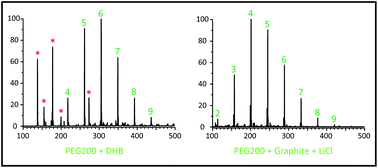A study of the application of graphite MALDI to the analysis of short-chain polyethylene glycols†
Abstract
The main goals in the analysis of synthetic polymers include the determination of the molecular weight, molecular weight distribution and dispersity along with complete characterisation of the chemical structure and end groups. These measurements must be made accurately and efficiently. Matrix-assisted laser desorption/ionisation mass spectrometry is a readily available and frequently used technique for the analysis of synthetic polymers. However, this can be challenging due to issues with matrix interference and analyte suppression as well as the suspected inability of shorter oligomer chains to bind cations with sufficient strength to survive the desorption/ionisation process. This has led to our study where we present the use of carbon-based matrices (specifically colloidal graphite) with polyethylene glycol polymers doped with LiCl as an appropriate and powerful methodology for the successful analysis of low molecular weight polymers.



 Please wait while we load your content...
Please wait while we load your content...